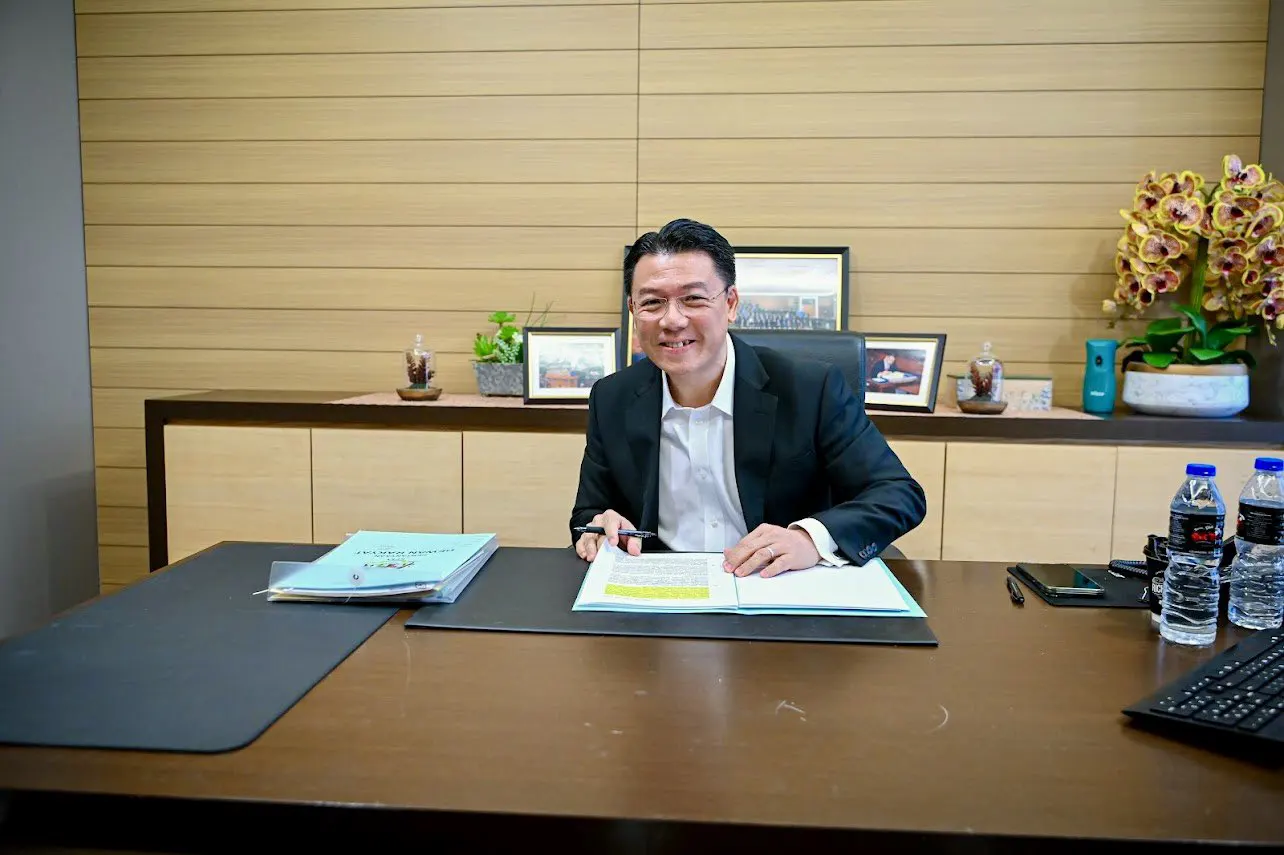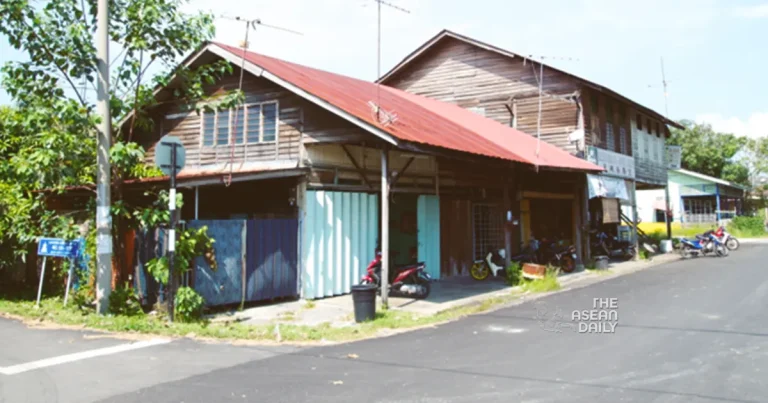18-3-2024 (KUALA LUMPUR) Nestled within the bustling Klang Valley, the suburb of Sungai Way bears all the trappings of a typical Malaysian township – a vibrant wet market, a stalwart police station, a school, and rows of shophouses lining its main thoroughfare. Yet, beneath this veneer of normalcy lies a dark and tumultuous history that has reignited impassioned debates about cultural recognition and the preservation of a contentious past.
Zinc-roofed shacks abut low-rise concrete buildings, and a few wooden kampung-style houses stand as defiant reminders of an era when their kind dominated the landscape. Some residences rise up to five storeys high, housing multiple families or serving as dormitories for workers employed at nearby factories. At a street corner, gleaming green dragons perch atop a bright orange building – the sole temple in this kampung baru cina, or Chinese new village, home to around 4,000 residents, predominantly Chinese, with a sprinkling of Malays and Indonesian permanent residents drawn to the area by employment opportunities.
Yet, this bustling enclave on the outskirts of Kuala Lumpur bears the scars of a dark past. It was one of 631 internment camps for the Chinese established across Peninsular Malaysia by British colonialists during the Malayan Emergency from 1948 to 1960, a period marked by a fierce communist insurgency against British rule.
A short-lived proposal to nominate seven of Selangor’s Chinese new villages as a UNESCO World Heritage site has ripped open old wounds and ignited racially charged debates about cultural recognition in Malaysia.
On February 1, Local Government Development Minister Nga Kor Ming announced that preparations were underway to seek UNESCO recognition for the “cultural and historical significance” of these villages. The UNESCO status, he asserted, would help promote Malaysian Chinese history and culture through tourism.

The news swiftly sparked a backlash, which eventually subsided after the Selangor government announced on March 5 that there were no plans to obtain the heritage site status for any villages in the state.
By then, Malay nationalists from UMNO and the opposition had vehemently condemned the idea. Historians, too, weighed in, with views ranging from the potential to preserve Chinese history and culture, to dismissals of the culture within the villages as “nothing special,” and accusations of exploiting a painful historical period for the sake of attracting tourist dollars.
On February 5, Wan Ahmad Fayhsal Wan Ahmad Kamal, the youth chief of the opposition party Parti Pribumi Bersatu Malaysia, challenged the “historical and unity value” of Selangor’s Chinese new villages, calling them “remnants of the Cold War where we fought the threat of the communist terrorists.”

He added: “It is more appropriate to designate Kampung Baru Kuala Lumpur as a UNESCO World Heritage site because its historical value makes the country more in line with the policy and identity of Malaysia.”
The 125-year-old Malay settlement with traditional wooden homes near the Petronas Twin Towers in the capital city has been under threat from urbanization. On March 13, the federal government confirmed that it has no plans to seek UNESCO heritage status for Kampung Baru, as that would impede development plans for the area.
UMNO framed Mr. Nga’s proposal as a challenge to the rights of the Malays as the country’s indigenous community.
“When an area is recognized as a World Heritage site, it also automatically recognizes the residents, their culture, language, and education as natives,” argued the party’s secretary-general, Asyraf Wajdi Dusuki, on February 9.
Mr. Nga countered the claims the same day, stating that the proposal for the new villages was “not a zero-sum game” and that others were welcome to nominate Malay villages or other places as UNESCO heritage sites.
The minister, who hails from the multiracial but Chinese-led Democratic Action Party, has often been accused by critics of undermining Malay-Muslim rights.
On March 11, he revealed in Parliament that the nomination of the Chinese new villages had been mooted by the International Council on Monuments and Sites (ICOMOS) Malaysia, which advises the UNESCO World Heritage Committee.
ICOMOS established a new village working group in March 2021 to study and assess the suitability of the Chinese new villages for nomination as a world heritage site, Mr. Nga said, adding that the current government was not in office at that time.
Former Petaling Jaya MP Kua Kia Soong had denounced the proposal as an “insult” to those who fought against British colonialism, arguing that the new villages were “nothing short of concentration camps, designed and enforced by the British colonial power.”
“Families were torn apart, livelihoods destroyed, and cultural heritage disregarded in the name of colonial supremacy,” said Mr. Kua, who is also the director of the human rights organization Suaram, in an open letter on February 13.
Proposing the inclusion of new villages under the UNESCO World Heritage sites “trivializes the trauma of those who suffered within their confines,” he added.
From the 1950s, thousands of rural villagers, particularly ethnic Chinese, had been forcibly relocated into “new villages” surrounded by barbed wire and sentry towers, to isolate them from the influence of communist guerrillas who were entrenched in the surrounding jungles.
The British government at the time believed that Chinese communities were providing assistance and supplies to the insurgents, either voluntarily or under coercion at gunpoint.
“The Chinese villagers had only around two days to pack everything and move. Some were forced into poverty,” Sungai Way New Village head Ding Eow Chai, 59.
“Those interred in these camps faced hardship. They lost their freedom. Many rich Chinese in the rural areas also lost their fortunes as they had to leave everything behind in the blink of an eye,” he added.
The Sungai Way village was originally founded in 1949 by Chinese who worked as rubber tappers and in tin mines in the surrounding area.
The British transformed it into a camp with 650 homes in 1950. Residents from the surrounding areas, including several Malay families, were uprooted and resettled in the village, where each family was given around 5,000 square feet of land to build their home.
A police station was built inside the camp itself to monitor and control the local population, while a Chinese school and a market were constructed to serve the new “villagers,” who were placed under curfews and movement controls.
Fifty-year-old Yuri Tan, a third-generation villager, said that her late grandfather needed multiple identification papers and permits to go in and out of the village while working as a rubber tapper.
“The authorities would check to see if he was taking more food than necessary when he went to work and also when he came home after purchasing food at the market. The families here also had food stamps. They could not purchase more rice per day than what was needed.
“The British didn’t want us to supply the communists,” said Ms. Tan, an artist.
Back then, her family home had a few bedrooms, a small kitchen with a wooden stove, a deep well, an indoor bathroom, an outhouse, a living area, and a pig sty.
Today, its wooden structure and attap roof are gone, replaced by renovations that also added modern amenities.
Eddin Khoo, president of the historical society Pusaka, expressed concern about the race-based arguments that arose in February over the UNESCO nomination plan.
“I am concerned about the opposition to it, which is basically saying that the history of Chinese new villages is not part of Malaysian history. There are serious consequences to it. To claim the Chinese new villages are not part of history is an attempt at suppression.
“History being written according to communal lines is repulsive, everyone has a history here. This segregation is nonsense. People are speculating and fictionalizing their community history, putting certain history in a position of prominence and downplaying others,” he said.
Despite the Selangor government’s shelved plans, Sungai Way village chief Ding still holds out hope that settlements like his will be recognized as heritage sites.
Mr. Ding also heads the village museum, which displays old photographs of the villagers’ daily lives in the internment camp, their personal items such as toys and wheelbarrows, maps, as well as the permits and identification documents they used then.
Obtaining heritage status, he said, will help promote volunteer-run, community-funded initiatives like these.
“So more people will be aware of what Chinese new villagers went through in the past,” said Mr. Ding.
As the echoes of a painful history reverberate through the streets of Sungai Way and other Chinese new villages, the debate over cultural recognition and the preservation of a contentious past rages on, a poignant reminder of the complexities that underpin Malaysia’s rich tapestry of diversity.




